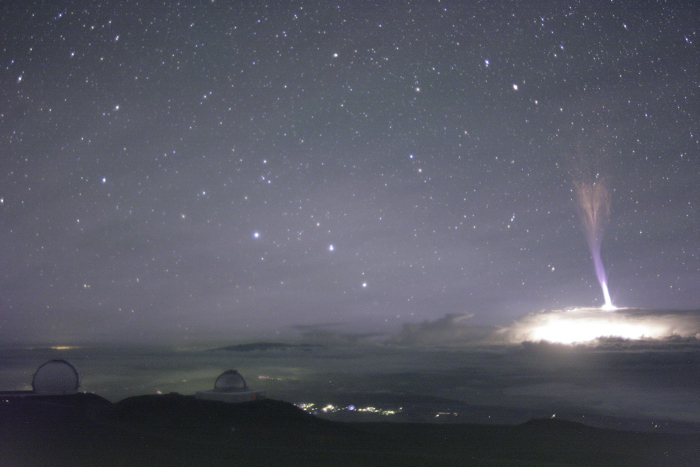Of all the weather phenomena our magnificent planet throws at us, lightning is one of the most spectacular - and the most mysterious. Even though storms are a regular occurrence, we're still at pains to understand and describe their crackling electrical discharges generated in the sky.
One kind of lightning is so strange and rare, in fact, that we didn't even have concrete evidence it existed until 1990, when researchers identified its signature 'rocket-like' motion in video shot from NASA's Space Shuttle the previous year.
Later dubbed 'blue jets', the streaks are now recognised as brilliant flashes of light that last just a few hundred milliseconds, as lightning streaks upwards from the clouds and into the stratosphere.
 A blue jet photographed in Hawai'i. (Gemini Observatory/AURA/Wikimedia Commons)
A blue jet photographed in Hawai'i. (Gemini Observatory/AURA/Wikimedia Commons)
We can't easily see this phenomenon beneath a curtain of clouds - but that doesn't mean scientists can't observe it from above them. Some 400 kilometres (250 miles) above the planet orbits the International Space Station, and for some time, instruments aboard have been watching for these mysterious flashes of upside-down lightning.
Now, after being installed in 2018, a European Space Station observatory equipped with optical sensors, photometers, and detectors for gamma and X-radiation has recorded five blue flashes from the top of a storm cloud, one of which ended with a blue jet streaking high into the stratosphere.
These rare glimpses provide some valuable insight into the onset of the mysterious discharges, according to a team of researchers led by physicist Torsten Neubert from the Technical University of Denmark.

Blue jets are thought to initiate when a positively charged cloud top meets a layer of negative charge at the cloud boundary and the layer of air above. This is thought to produce an electrical breakdown that forms a leader - an invisible conductive channel of ionised air along which the lightning travels.
However, our understanding of the blue jet leader is pretty limited. This is where the data analysed by Neubert and his team are filling gaps.
On 26 February 2019, the Atmosphere-Space Interactions Monitor (ASIM) observatory recorded five blue flashes, around 10 microseconds long each, in the top of a stormcloud, not far from the island of Nauru in the Pacific Ocean.
One of these flashes produced a blue jet, reaching as far as the stratopause - the interface between the stratosphere and the ionosphere, at an altitude of about 50 to 55 kilometres (around 30 to 34 miles).
In addition, the observatory recorded atmospheric phenomena called ELVES (short for Emission of Light and Very Low Frequency perturbations due to Electromagnetic Pulse Sources). These are expanding rings of optical and ultraviolet emission in the ionosphere that appear above storm clouds, lasting just a millisecond or so, as illustrated in the animation below.

They're thought to be generated by an electromagnetic pulse at the bottom of the ionosphere, caused by lightning discharge.
Red emission from the leader, however, was faint and very limited. This, the research team said, suggests that the leader itself is very short and localised, compared to fully developed lightning leaders between the ground and clouds.
This also suggests that the flashes and the blue jet itself are a type of discharge streamers: branched, writhing sparks striking out of high voltage sources, like Tesla coils, on a chain-reaction of ionising air particles.
"We propose then, that the UV pulses are elves that are generated by the streamer flash currents, rather than by lightning currents," the researchers write in their paper.
The flashes, they believe, are similar to narrow bipolar events. These are high-power radio-frequency discharges that occur inside clouds during thunderstorms, which are known to trigger lightning within the cloud. The blue flashes in the cloud tops, the team said, are likely the optical equivalent of this phenomenon, and can develop into blue jets.
Since narrow bipolar events are quite common, this could mean that the blue flashes are also more common than we thought. Knowing more about how common they are could give us a much better understanding of storms and lightning, not to mention our atmosphere, and all the complex interactions therein.
The team's research has been published in Nature.
